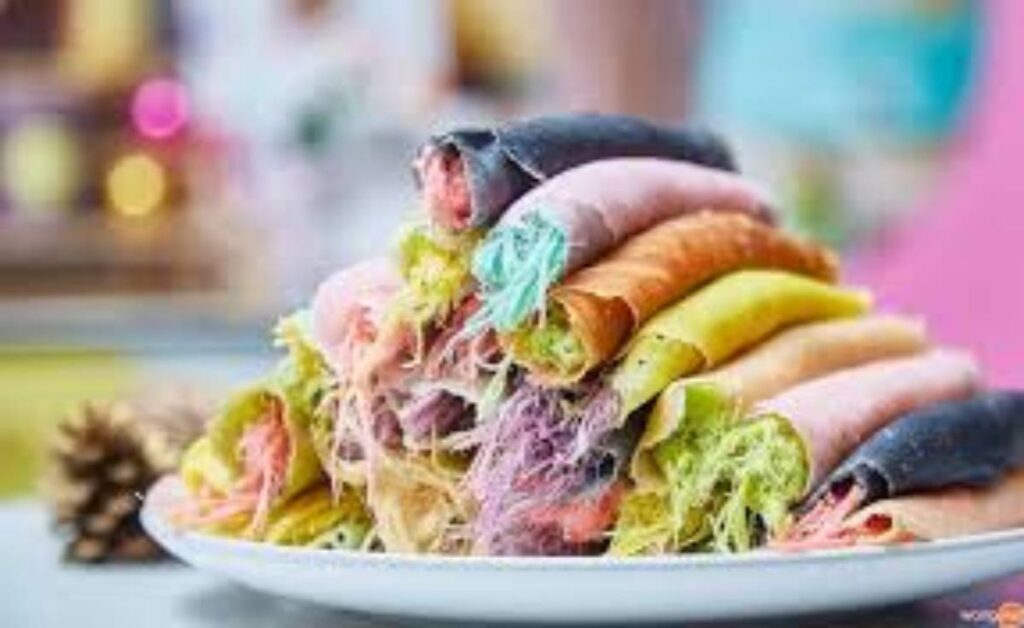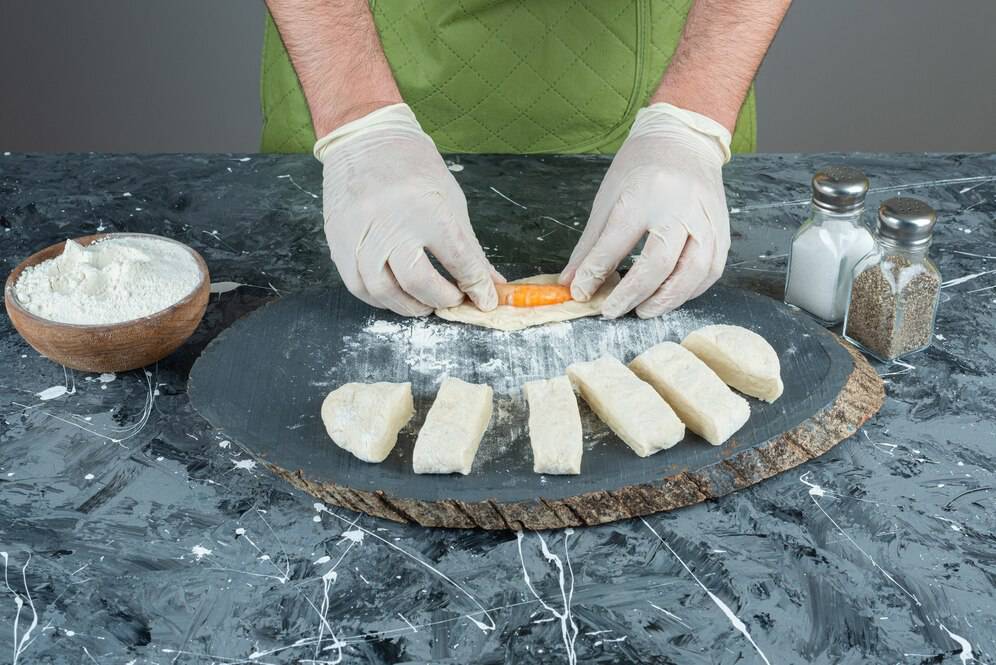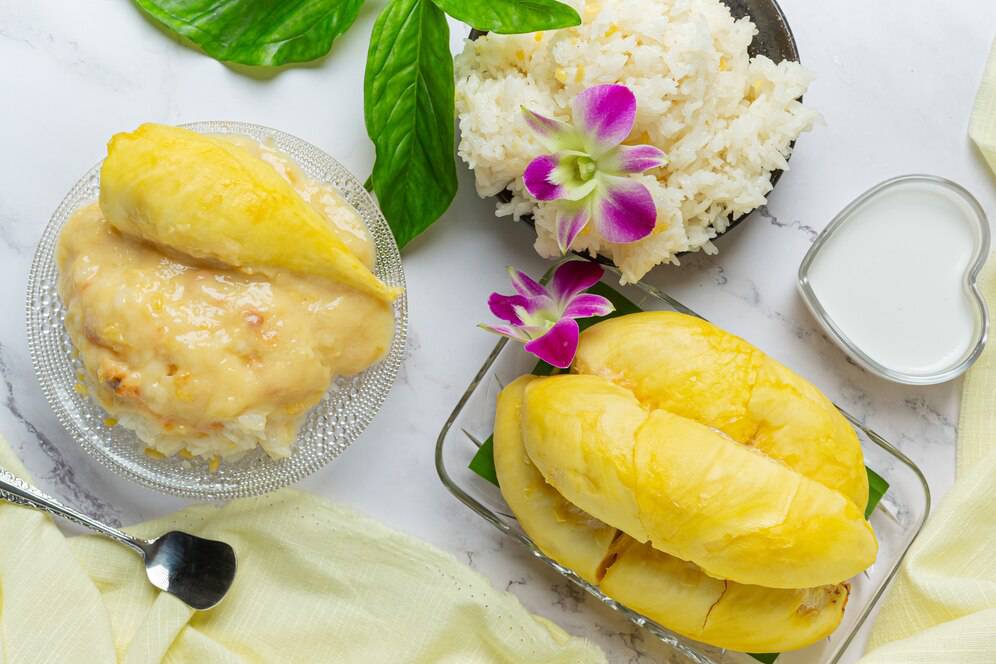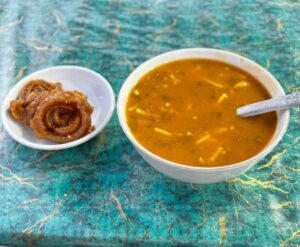The Food & Recipes Blog

Thailand’s Roti Sai Mai: Sweet Cotton Candy Wraps
If you’ve ever meandered through one of Thailand’s busy markets, chances are you’ve spied colourful wisps of spun sugar wrapped tightly into crepe-like packages. Roti sai mai is a popular Thai street snack that entices locals and tourists alike. With its bright threads of sugary, sweet sameness and soft, chewy roti, this snack is not just delightful—it’s marvelously intertwined in the tapestry of Thai food culture.
But what is roti sai mai exactly? Where did it originate? And why has it become a must-try for anyone interested in Thai cuisine? In this blog, we will explore the beautiful world of Thai cotton candy, from its roots, craft, and flavours to the cultural significance this dessert holds.
What is Roti Sai Mai?
A Thai Take on Candy Floss and Crêpes
Roti sai mai (โรตีสายไหม) is a popular Thai street dessert made from two main components:
- Roti: A thin, chewy crêpe, similar in appearance to a tortilla, but softer and slightly sweeter.
- Sai mai: Thai-style cotton candy, spun from caramelised sugar into silky threads.
The eater wraps the cotton candy inside the roti, creating a delightful combination of textures—soft, fluffy sweetness against the warm, stretchy wrap. It’s a simple, satisfying snack often sold by street vendors across Thailand, particularly in Ayutthaya, where it’s most famously known.
Origins and Cultural Significance
From Persian Roots to Thai Streets
Though it’s a beloved Thai dessert today, roti sai mai has foreign roots. It’s widely believed that the treat originated with Thailand’s Muslim communities, particularly those of Persian descent, who brought with them roti-making traditions.
In Ayutthaya, the ancient capital of Thailand, Muslim vendors began creating this hybrid treat, spinning sugar into floss and wrapping it in soft roti. Over time, roti sai mai became a signature snack of the region, often found at night markets and festivals.
Its popularity spread rapidly due to:
- Accessibility: Affordable ingredients and simple preparation.
- Portability: Easy to carry and eat on the go.
- Visual appeal: Brightly coloured sugar threads and fresh-pressed roti make resisting hard.
Today, roti sai mai is considered a local delicacy and a cultural symbol, particularly during Thai holidays and temple fairs.
How It’s Made: The Craft of Roti Sai Mai
A Blend of Skill and Sweetness
Creating roti sai mai is an art form that demands precision and patience. Here’s a closer look at how this sweet street snack is made:
1. Preparing the Sai Mai (Cotton Candy)
- Ingredients: Typically, it consists of sugar, water, and sometimes natural colourings (e.g., pandan or butterfly pea).
- Process: The sugar is boiled into a syrup, then cooled slightly before being pulled and folded repeatedly, like making pulled noodles, until it turns into fine, hair-like threads.
These threads are usually vividly coloured, and natural ingredients are often used for aesthetic and flavour enhancement.
2. Making the Roti Wrap
- Dough: Made from wheat flour, water, salt, and oil.
- Technique: Small dough balls are pressed and cooked quickly on a hot pan until just cooked through—no browning, to keep them soft and pliable.

3. Wrapping It Up
The finished product is as simple as indulgent: a small handful of cotton candy is placed inside a roti, then rolled up like a burrito or folded like an envelope. Some vendors offer flavoured rotis or sprinkle sesame seeds for added texture.
Why It’s So Popular: The Allure of Thai Cotton Candy
More Than Just a Treat
There’s something universally appealing about roti sai mai. Perhaps it’s the whimsical look—colourful, cloud-like sugar wrapped in a warm crepe. Or maybe it’s the texture contrast that makes each bite memorable.
Here’s why this snack continues to win hearts:
- A feast for the eyes: Bright pastel hues make it highly Instagrammable.
- Affordable indulgence: Costing just a few baht, it’s accessible to all.
- Cultural connection: Eating roti sai mai is a nostalgic experience for many Thais, often linked to childhood and family outings.
- Tourist favourite: Visitors often see it as a uniquely Thai experience.
Roti Sai Mai in Ayutthaya: A Must-Try Experience
The Sweet Capital of Roti Sai Mai
If you’re in Thailand and want to taste the best roti sai mai, Ayutthaya is the place to be. Street stalls line the roads, especially around tourist hotspots and temples, where vendors display bundles of multicoloured sai mai alongside stacks of freshly made rotis.
Pro tip: Look for vendors making it fresh on-site. Watching the sugar being spun and the roti pressed adds a memorable layer to the experience.
In recent years, some sellers have even begun offering modern twists:

- Flavoured floss: Durian, mango, coconut, and Thai tea.
- Infused wraps: Pandan, charcoal, or even matcha crepes.
These variations maintain the essence of the original while catering to evolving palates.
Comparing Roti Sai Mai with Other Sweets
How Does It Stack Up Against Global Treats?
Roti sai mai shares similarities with other global sweets, though it maintains a distinctly Thai character.
| Sweet Treat | Country | Similar to Roti Sai Mai |
| Pişmaniye | Turkey | Flossy texture; made from pulled sugar & flour |
| Dragon’s Beard Candy | China | Pulled sugar strands, similar to a texture |
| Cotton Candy | Global | Both involve spun sugar, but different techniques |
| Crêpes | France | Similar in wrap texture, but with different fillings |
Unlike standard cotton candy, sai mai is hand-pulled, resulting in a more delicate and less airy texture. Combined with the roti, it creates a balanced snack, not too sweet or heavy.
Nutritional Considerations
Is Roti Sai Mai Healthy?
Let’s be honest—roti sai mai is a treat, not a health food. It primarily contains sugar and carbohydrates, so it should be enjoyed in moderation. However, some vendors now offer:
- Natural colourings (avoiding artificial dyes)
- Reduced sugar options
- Whole wheat or gluten-free roti alternatives
If you’re watching your sugar intake, consider sharing a portion or opting for a smaller wrap. You can still enjoy the flavour and experience without overindulging.
The Global Spread of Roti Sai Mai
A Taste of Thailand Abroad
As Thai cuisine gains popularity worldwide, roti sai mai is starting to appear at food festivals, Thai cultural events, and select international dessert shops. While it’s still a niche item outside Thailand, the demand is growing, particularly among:
- Food tourists seeking authentic experiences
- Chefs and influencers are introducing global fusion desserts
- Thai communities abroad preserving culinary traditions
Thai cotton candy is becoming a global sweet ambassador from Bangkok to London and Los Angeles.
Why You Should Try Roti Sai Mai
Thailand’s roti sai mai is not just a sweet treat but a colourfully embedded aspect of Thai heritage that reflects the nation’s culinary creativity and cultural richness. It represents the essence of Thai street food—affordable, delectable, and memorable—from its Persian-influenced roots and peripatetic evolution on colourful street stalls to its present form.
Whether wandering the night markets of Ayutthaya or sampling Thai food from afar, don’t forget to grab this sweet street snack. It’s a visual experience, a taste bud delight and a taste of a long gastronomic history.
So, are you ready to witness the magic of Thai sweet dishes? Look for roti sai mai at your next food fair or Thai market, and if you’re travelling to Thailand, add it to your foodie to-do list.









